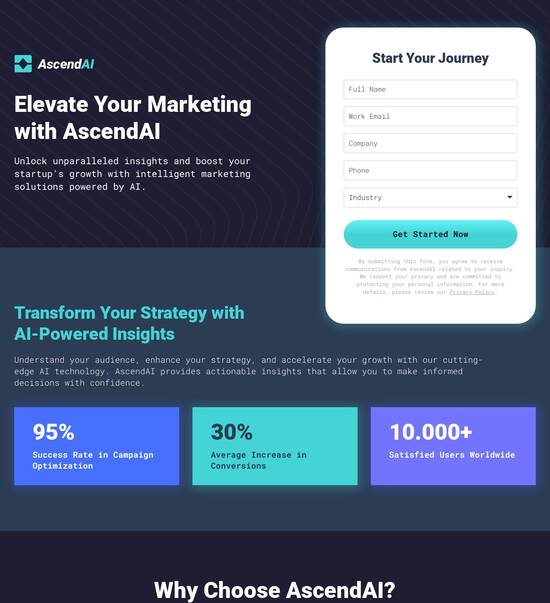
HTML page template for Network administrators
Use TemplateAbout template
Attract clients and showcase your skills with style using our landing page templates for Network administrators. Let's convert those visitors into clients!
Recommended templates

Easy to build without coding
With the intuitive drag-and-drop builder, anyone on your team can create high-converting pages without any knowledge of code or design. Make enhancements to your landing page with custom widgets using Javascript, HTML/CSS, or third-party scripts.

Multiple layouts for any industry and goal
Select from 500+ landing page layouts built to boost conversions across industry-specific scenarios. Customize them by adjusting fonts, adding images, and generating on-brand content with the AI assistant. Quickly scale with Instablocks® and Global Blocks that you can save, reuse, and update globally.

Loads fast and looks polished on any device
Every template is responsive, which means they present professionally on any device and load blazingly fast with our Thor Render Engine. You can also power them up with Google AMP technology to deliver an unparalleled mobile experience and drive higher conversions.

Robust analytics & experimentation
Get real-time updates and reporting across all your devices, showing the number of visitors, conversions, cost-per-visitor, and cost-per-lead. Launch AI-powered experiments, run A/B tests, and use heatmaps to analyze user behavior, then optimize your landing page to maximize conversions.







Easy to build without coding
With the intuitive drag-and-drop builder, anyone on your team can create high-converting pages without any knowledge of code or design. Make enhancements to your landing page with custom widgets using Javascript, HTML/CSS, or third-party scripts.
Multiple layouts for any industry and goal
Select from 500+ landing page layouts built to boost conversions across industry-specific scenarios. Customize them by adjusting fonts, adding images, and generating on-brand content with the AI assistant. Quickly scale with Instablocks® and Global Blocks that you can save, reuse, and update globally.
Loads fast and looks polished on any device
Every template is responsive, which means they present professionally on any device and load blazingly fast with our Thor Render Engine.
Robust analytics & experimentation
Get real-time updates and reporting across all your devices, showing the number of visitors, conversions, cost-per-visitor, and cost-per-lead. Launch AI-powered experiments, run A/B tests, and use heatmaps to analyze user behavior, then optimize your landing page to maximize conversions.
All the features you need to build lead-generating landing pages
Explore more featuresLearn how to build top-performing landing pages for any goal
FAQs
Leading the way in building high-performing landing pages





A step-by-step guide to using Instapage for landing page optimization
Creating effective landing pages is crucial in digital marketing, and Instapage offers a robust platform to elevate your online campaigns. With features designed specifically for marketers in a variety of industries like tech, education, and financial services, Instapage helps optimize conversions and maximize ROI with ease.
Understanding the power of Instapage for landing page creation
Instapage stands out as the most powerful landing page and CRO platform available, enabling users to build and optimize pages without the need for coding. This tool allows marketers to create personalized experiences, maximizing engagement and conversion potential. Below are some key benefits of using Instapage's features:
- Access to over 100 high-converting templates ensures quick and efficient landing page creation.
- Built-in A/B testing features facilitate optimization by offering actionable insights into user behavior.
- Dynamic text replacement allows for personalized content delivery, increasing the relevance of marketing messages.
Step 1: Choosing the right template to kick off your campaign
Using the right template can significantly influence your campaign's success. Choose a high-converting template that aligns with your marketing objectives. Here’s how to proceed:
- Review your campaign goals: Define the primary purpose of your landing page, whether it's lead generation, product sales, or event registrations.
- Select a template: Browse through the 100+ conversion-focused templates available on Instapage and select one that fits your brand’s aesthetic.
- Customize for niche audiences: Adjust the content and visuals to address the specific interests and pain points of your target audience.
Step 2: Optimize your landing page for higher conversions
Once your template is set, the next step involves optimizing for conversions. Utilize the following features:
- Conduct A/B testing: Leverage the A/B testing tools to compare different variations of your landing page.
- Use heatmaps: Analyze where visitors are clicking and adjust elements accordingly to improve user experience.
- Incorporate personalization: Implement dynamic content that adapts to the user’s demographics or previous interactions to keep them engaged.
Step 3: Collaborate and launch your landing page
Collaboration is key to refining your landing page before launch. Here’s how to ensure your page is ready:
- Utilize collaborative feedback: Share your page with team members and gather real-time feedback for improvements.
- Review performance metrics: Use Instapage’s analytics tools to assess the expected performance of your landing page before it goes live.
- Launch and monitor: After securing stakeholder buy-in, publish your landing page and continue to monitor its performance for further optimizations.
Following these steps will help you leverage Instapage effectively, ensuring your landing pages resonate with your audience.
Ready to transform your marketing campaigns and maximize your ROI? Start using Instapage today and experience the power of optimized landing pages!
People also ask about HTML page template for Network administrators
HTML page template for network administrators: A comprehensive guide
Understanding the role of HTML page templates for network administrators
HTML page templates serve as vital tools for network administrators, streamlining workflows and enhancing communication across teams. By providing a consistent framework for presenting network data, these templates allow administrators to manage their resources more efficiently. In the realm of network management, time is of the essence, and templates can significantly cut down on the hours spent manually formatting data or creating reports from scratch.
Collaboration is paramount in network administration, where multiple stakeholders, such as IT teams, management, and end-users, need to share insights and updates. HTML templates facilitate this process by standardizing the presentation of information. Such uniformity ensures that everyone is on the same page, leading to improved decision-making and faster response times.
Readability and code structure: A well-structured HTML template enhances readability for developers and network personnel alike.
Integration with network monitoring tools: The best templates have built-in support for integrating with existing infrastructure and monitoring solutions.
Customizability: Templates should be adaptable to different networks, allowing administrators to tailor them to their specific needs.
The structural components of an effective HTML template
An effective HTML page template begins with a solid foundational structure. Each HTML document is comprised of essential components that dictate how content is displayed and interacted with on the web. At its core, an HTML document starts with a document type declaration that informs the browser of the HTML version being used, typically followed by the HTML opening and closing tags that encompass all content.
The head section is crucial, containing meta tags that define character set and viewport settings for responsive design, as well as links to CSS stylesheets which dictate how the page appears visually. On the other hand, the body section houses the visible elements of the page, including headers, footers, and the main content area where essential information resides.
Document type declaration and HTML tags: Essential for browser rendering.
Head section essentials: Including meta tags, title, and links to stylesheets.
Body section organization: Properly structured for accessibility and readability.
Utilizing CSS is the next step for enhancing styling within HTML templates. CSS can be implemented in various ways: inline, embedded, or external, each with its advantages and disadvantages. For high flexibility and maintainability, external CSS files are recommended, as they separate content from presentation. Additionally, responsive design can be efficiently achieved using frameworks like Bootstrap or Foundation, which provide pre-defined styles and grid layouts that adapt well to different screen sizes.
Utilizing JavaScript for dynamic functionality
JavaScript plays a pivotal role in enhancing HTML page templates, especially for network administrators who require more than just static information display. Through JavaScript, administrators can create interactive elements that improve user engagement and streamline the management of network resources. This can include features such as forms that validate input or panels that update in real-time to reflect the current state of the network.
The use of event listeners, such as `document.addEventListener`, allows network administrators to trigger functions based on user interactions like clicks, scrolling, or key presses. For instance, a template might include a dynamic notification feature that updates users when a network issue arises, allowing for quicker response times to potential problems.
Enhancing user interactions: JavaScript makes templates more engaging.
Real-time data updates: Output can reflect changing network conditions instantly.
Understanding DOMContentLoaded: A key lifecycle event
Learning about the DOMContentLoaded event is crucial for network administrators utilizing HTML templates. This event signifies that the initial HTML document has been completely loaded and parsed, allowing scripts to run effectively. Timing is important; scripts that run too early might fail if the DOM elements they seek to manipulate do not yet exist. Hence, proper use of this event ensures that JavaScript functions interact with a fully constructed DOM, optimizing performance and interactivity.
Furthermore, understanding the differences between DOMContentLoaded and other lifecycle events, such as `load` or `beforeunload`, can greatly benefit template functionality. The `load` event waits for all media and stylesheets to load before executing, which can delay interactivity unnecessarily. Conversely, leveraging the DOMContentLoaded event allows for scripts to initiate without delay, providing a smoother user experience.
Ensuring scripts run after the DOM is constructed avoids errors.
Improves overall user experience and interaction responsiveness.
Advanced features for network administration templates
In the context of network administration, advanced features within HTML templates can significantly elevate the management experience. By incorporating network monitoring APIs, templates can provide real-time traffic analysis and visualizations that help administrators monitor their networks effectively. This means that information such as bandwidth usage, device status, and alerts for network changes can be dynamically reflected within the template, allowing for informed decision-making.
Dashboards that showcase key performance indicators (KPIs) relevant to network health are invaluable. By displaying essential metrics, administrators can quickly identify potential bottlenecks or issues. Visualization tools, such as graphs, charts, and tables, not only make data analysis easier but also enhance communication with other departments by presenting information in an accessible format.
Real-time traffic analysis: Keeping the pulse on network performance.
Alerts and notifications: Immediate awareness of network fluctuations.
Enhancing HTML templates with modern JavaScript frameworks
The incorporation of modern JavaScript frameworks such as React, Vue, or Angular can transform the way HTML page templates are built and maintained for network administration. These frameworks allow administrators to develop interactive user interfaces effortlessly and capitalize on component-based architecture, which promotes reusability. Instead of duplicating code for every instance of a feature, it’s easier to develop isolated components that can be integrated where needed, saving both time and effort.
Another compelling benefit is the seamless integration with RESTful APIs, which facilitate data exchange and updates for network data. By fetching live network metrics, these frameworks can dynamically update user interfaces without requiring full page reloads, providing a smoother experience for users. This is particularly useful in fast-paced network environments where quick decision-making is critical.
Ease of building interactive UIs: Modern frameworks simplify user interface development.
Component-based architecture: Promotes efficient coding practices.
Best practices for maintaining HTML templates
Maintaining HTML templates requires a focus on version control to track changes and collaborate effectively. Utilizing version control systems, like Git, enables network administrators to manage revisions, thereby facilitating collaborative work among team members. Developing a clear versioning strategy helps in rolling back to previous iterations if needed, ensuring that critical updates or bug fixes can be implemented without jeopardizing the existing functionalities.
Frequent testing and optimization are also vital in maintaining the integrity of HTML templates. Administrators should adopt techniques for debugging both HTML and JavaScript to ensure that the templates function correctly across various browsers and devices. Moreover, implementing performance optimization strategies, such as minimizing resource sizes and reducing the number of DOM manipulations, helps to maintain fast load times and an overall smooth user experience.
Importance of Git for team collaboration: Version control system advantages.
Strategies for maintaining and updating templates: Documenting changes and ensuring functionality.
Techniques for debugging HTML and JavaScript: Essential for troubleshooting.
Case studies and real-world applications
Examining successful implementations of HTML page templates can offer valuable insights for network administrators. For instance, telecommunications companies have utilized these templates to enhance customer feedback mechanisms, leading to quicker adjustments in service provisioning in response to user experiences. Furthermore, educational institutions have leveraged similar approaches to monitor their internal networks, ensuring that faculty and students have access to the resources they need.
Common challenges include ensuring compatibility with various network conditions and maintaining consistent performance across both wired and wireless environments. However, many organizations have navigated these hurdles by focusing on thorough testing and user feedback, ultimately enhancing their overall network performance and reliability.
Telecommunications companies: Improving customer experience through efficient feedback.
Educational institutions: Monitoring network performance to support learning.
Preparing for the future: Evolving HTML template strategies
As technology continues to evolve, so too must the strategies for HTML templates in network management. Observing current trends such as artificial intelligence and machine learning can unveil opportunities for higher levels of automation and efficiency in network operations. For example, predictive analytics can aid in anticipating network issues before they arise, leading to proactive adjustments rather than reactive measures.
Additionally, the rise of low-code/no-code solutions has made template creation more accessible, allowing network administrators with limited programming skills to create or modify templates according to their needs. Building flexible, future-proof templates requires consideration of scalability, ensuring that as networks grow, the templates can easily accommodate increased demands and further innovations in web standards, such as HTML5 and CSS3.
Trends in web technologies: AI and machine learning as transformative forces.
Building templates for scalability: Ensuring adaptability to growth.
Ready to skyrocket conversions?
Supercharge your ad campaigns with high-performing landing pages
Get started














